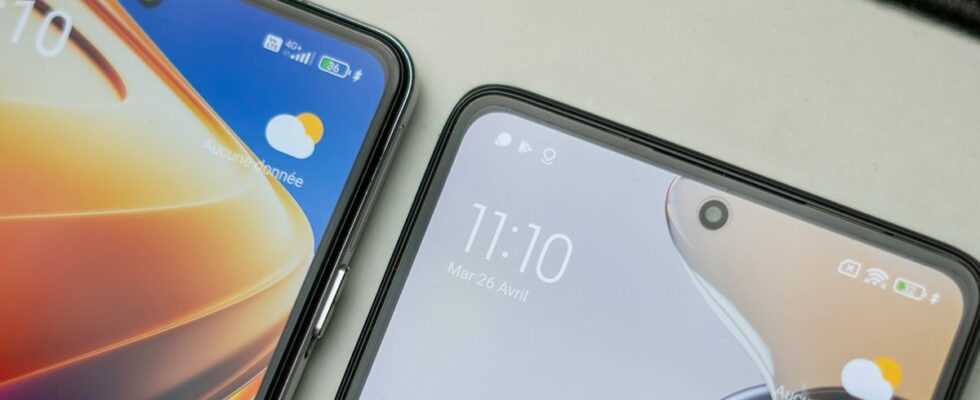4
What is the impact of ultra-fast charging at 120 W on the heating of a smartphone? This is what we tried to see on the new Poco F4 GT as well as on the Xiaomi 11T Pro.
Poco F4 GT
In the absence of offers discover
Xiaomi 11T Pro 5G

 Fnac.com Used Marketplace
Fnac.com Used Marketplace382.99
 Used Amazon Marketplace
Used Amazon Marketplace430.00
 Amazon Marketplace
Amazon Marketplace450.00
 eBay
eBay476.15
Shopping street
481.59
 Cdiscount Marketplace
Cdiscount Marketplace482.99
 Rakuten
Rakuten485.00
 reBuy
reBuy494.99
Topbiz.fr
559.78
 Fnac.com
Fnac.com629.00
 baker.com
baker.com629.00
 Darty.com
Darty.com629.00
 La Redoute Marketplace
La Redoute Marketplace629.00
 Cdiscount
Cdiscount633.99
 Ubaldi
Ubaldi679.00
 RED by SFR
RED by SFR699.00
Xiaomi official website
699.90
 Materiel.net
Materiel.net706.90
 LDLC
LDLC707.90
 SFR
SFR709.00
How the pricing table works
Just announced, the Poco F4 GT is already in our hands. Its promising technical sheet requires us to compare it to our laboratory tests, starting with those dedicated to recharging. Indeed, the smartphone has ultra-fast charging at 120 W. Enough to allow the F4 GT to refuel very quickly. But what is its impact on its battery and especially on its heating?
The new Poco F4 GT is not the first smartphone from Xiaomi to benefit from super fast 120W charging. The Xiaomi 11T Pro was the first to offer a huge charging block when it was released in the fall of 2021, and we had measured its power on the occasion of a dedicated article.
The Poco model announces that it can regain its full autonomy in the space of 17 minutes with a 4700 mAh battery. This is what is also announced for the 11T Pro, which however has a larger battery (5000 mAh). Note that if the Xiaomi model accepts a power of 120 W out of the box, this is not the case with our Poco. Its charging speed turns out to be limited by default, without the user being told which power is then preferred. To enjoy these 120 W, you must activate a hidden option in the battery settings. A warning indicating that switching to a full 120 W load may heat up your smartphone a little more is also displayed.
A block of 120 W is imposing compared to one of 15 W, but not necessarily more than one of 33 or 65 W.
Unequal heating
In our experiment, we charged both phones from flat, with the first to reach 100% signaling the end of our test (so the Poco F4 GT was the fastest ). Every five minutes, we took a photo of the devices using a thermal camera, in order to follow the evolution of the temperature on the two smartphones. All in all, 25 minutes were needed.
What we observed is telling enough. During the first 15 minutes of our experiment, we noticed that the Poco F4 GT heated up all over the surface. A heating observable from the 5th minute and which increased slightly over the next 10. The smartphone therefore heats up immediately when it is recharged. This heating is also felt to the touch – the Mi 11T is indeed slightly colder. The process can be summarized as follows:
- In 5 minutes, the temperature is already at 33.5°C at the USB-C port and the charging cable.
- The temperature of the F4 GT climbs to 34.9°C after 10 minutes, on its lower part. At this time, the Poco is therefore the hotter of the two smartphones.
- At 15 minutes, the entire surface of the F4 GT is heated (the red visible on the pictures), but it is on the 11T Pro that we find the hottest point: 34.7 ° C at the level of the photo island.
- After 20 minutes, the heating reaches its maximum on the 11T Pro with 34.9 ° C (what we had at the start on the Poco F4 GT). It is stabilized until the end of the test, when the Poco reaches 100% charge.
On the left, the Poco F4 GT; on the right, the Xiaomi 11T Pro. In order: the heating temperatures recorded at 5, 10, 15, 20 and 25 minutes.
By recharging the Poco F4 GT at 120 W, we noticed a slightly more marked heating after 15 minutes (it takes 17 to regain its 100%), with 36.8 ° C on its upper part. A localized release of heat, since it would seem that with the load at 120 W, the smartphone heats up less evenly. What we do not find when it is restrained.
The heating noted on the Poco F4 GT after 15 minutes, with the full load at 120 W activated.
The battery reaches its hottest point (44.6°C) after 10 minutes of charging at 120 W. © Viser.
What conclusions can be drawn ?
First, the vapor chamber present in the Poco F4 GT does not seem to help the smartphone heat up less when charging. The latter is mainly used when you play with the phone, to avoid the discomfort associated with excessive heating during long gaming sessions. However, it does not work like a fan which would cool the smartphone whatever the circumstances.
Then, the Xiaomi 11T Pro seems to manage its heating slightly better, since the latter only reaches its peak after 20 minutes, where the F4 GT is familiar with it from the start of its recharge test. A heating which therefore does not seem as well controlled on the Poco model as on the Xiaomi. A shame for a smartphone designed for mobile gamers.
In any case, this heating (below 37°C) is neither incredible nor exceptional. You don’t have to worry about it more than reason. Fortunately, it remains quite similar to what we find on other smartphones on the market.
